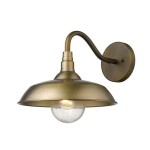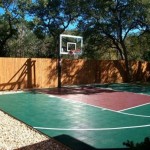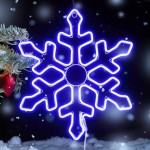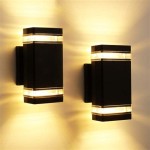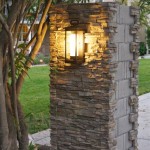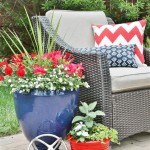Illuminating History: A Guide to Vintage Outdoor Wall Lighting
Vintage outdoor wall lighting offers a unique blend of aesthetic appeal and historical significance, providing homeowners with an opportunity to enhance their properties with pieces that tell a story. These fixtures, often crafted from durable materials like cast iron, brass, and copper, stand in stark contrast to modern mass-produced alternatives. Exploring the nuances of vintage outdoor wall lighting involves understanding its diverse styles, historical context, restoration techniques, and practical considerations for modern installation. This article aims to provide a comprehensive overview of these aspects, guiding enthusiasts and homeowners in their pursuit of authentic vintage lighting solutions.
Recognizing the Diverse Styles of Vintage Outdoor Wall Lighting
The term "vintage" encompasses a broad range of styles and eras, each reflecting the prevailing design trends and manufacturing capabilities of its time. Understanding these stylistic differences is crucial for selecting fixtures that complement the architectural character of a home. Common styles include Victorian, Arts and Crafts, Art Deco, and Mid-Century Modern, each characterized by distinct features.
Victorian-era lighting (roughly 1837-1901) is often ornate and elaborate, drawing inspiration from Gothic Revival and Renaissance Revival designs. Fixtures tend to feature intricate castings, scrollwork, and decorative details like floral motifs and stylized leaves. Materials commonly used include cast iron, often painted black or dark green, and brass accents. Glass shades are typically ornate, featuring etched patterns or colored glass panels. These fixtures provided a sense of grandeur and sophistication, reflecting the affluent lifestyles of the Victorian era.
The Arts and Crafts movement (roughly 1880-1920), in contrast, emphasized simplicity, craftsmanship, and natural materials. Outdoor wall lights from this period typically feature clean lines, geometric shapes, and a focus on highlighting the beauty of the materials used. Common materials include copper, bronze, and wrought iron, often with a hand-hammered finish. Glass shades are typically made of amber or opal glass, often with a hammered or art glass texture. The emphasis was on functionality and durability, reflecting the movement's commitment to honest design and quality craftsmanship.
Art Deco lighting (roughly 1920-1939) embraced modernity and technological advancements, incorporating geometric shapes, streamlined designs, and luxurious materials. Outdoor wall lights from this era often feature chrome, polished nickel, and aluminum, reflecting the era's fascination with speed and efficiency. Glass shades may be made of frosted or colored glass, often with geometric patterns or stepped designs. The focus was on creating visually striking and glamorous fixtures that reflected the optimism and energy of the interwar period.
Mid-Century Modern lighting (roughly 1945-1965) is characterized by its minimalist aesthetic, clean lines, and focus on functionality. Outdoor wall lights from this period often feature simple geometric shapes, such as spheres, cones, and cylinders, made from materials like aluminum, steel, and plastic. Glass shades are typically made of frosted or opal glass, often with a simple, unadorned design. The emphasis was on creating practical and aesthetically pleasing fixtures that complemented the modern architecture of the time.
Restoration and Preservation of Vintage Lighting Fixtures
Restoring vintage outdoor wall lighting requires a careful and methodical approach to preserve its historical integrity while ensuring its safe and reliable operation. The process typically involves cleaning, repairing, and rewiring the fixture. It is highly advisable to consult with experienced professionals when dealing with electrical components, particularly in older fixtures where insulation may be brittle or damaged.
Cleaning vintage lighting fixtures involves removing years of accumulated dirt, grime, and corrosion. Gentle cleaning methods are essential to avoid damaging the original finish or delicate materials. A soft cloth and mild detergent are typically sufficient for removing surface dirt. For more stubborn grime, a specialized metal cleaner may be necessary, but it is crucial to test the cleaner on an inconspicuous area first to ensure it does not damage the finish. For cast iron fixtures, a wire brush can be used to remove rust, followed by a rust inhibitor to prevent further corrosion.
Repairing vintage lighting fixtures often involves addressing structural issues, such as broken castings, loose joints, or damaged glass shades. Cast iron and brass components can be repaired by welding or soldering, but it is crucial to use appropriate techniques and materials that are compatible with the original construction. Replacement glass shades can be sourced from antique dealers or custom-made to match the original design. When replacing parts, it is important to strive for authenticity, sourcing components that are similar in style and material to the original.
Rewiring vintage lighting fixtures is essential for ensuring their safe and reliable operation. Old wiring can become brittle and cracked over time, posing a fire hazard. It is advisable to replace the old wiring with modern, UL-approved wiring that meets current safety standards. When rewiring, it is important to use appropriate wire gauges and connectors, and to ensure that all connections are properly insulated. It is highly recommended to consult with a qualified electrician to perform this task, as it involves working with electrical components and requires specialized knowledge and skills.
Practical Considerations for Modern Installation
Installing vintage outdoor wall lighting in a modern setting requires careful consideration of several factors, including electrical codes, weather resistance, and compatibility with existing electrical systems. Proper installation is crucial for ensuring the safety and longevity of the fixtures.
Adherence to local electrical codes is paramount when installing vintage lighting fixtures. These codes specify the requirements for wiring, grounding, and weatherproofing, ensuring that the installation meets safety standards. It is essential to consult with a qualified electrician to ensure that the installation complies with all applicable codes. In many jurisdictions, a permit may be required for electrical work, so it is important to check with local authorities before beginning the installation.
Weather resistance is a critical consideration for outdoor lighting fixtures, particularly in regions with harsh climates. Vintage fixtures may not have been originally designed to withstand modern weather conditions, so it is important to take steps to protect them from the elements. This may involve applying a protective coating to the metal surfaces, sealing any gaps or cracks, and using weatherproof bulbs and sockets. Regular maintenance, such as cleaning and inspecting the fixtures, can also help to prolong their lifespan and prevent damage from the elements.
Compatibility with existing electrical systems is another important consideration. Vintage lighting fixtures may require different voltage or wattage than modern fixtures, so it is important to ensure that the existing electrical system can accommodate the new fixtures. This may involve upgrading the wiring, replacing the circuit breaker, or installing a transformer. It is also important to consider the placement of the fixtures and the availability of electrical outlets. In some cases, it may be necessary to run new wiring to accommodate the new fixtures, which can be a complex and costly undertaking. Consulting with a qualified electrician is essential to ensure that the installation is safe and compatible with the existing electrical system.
Beyond the technical aspects, consider the light output. Incandescent bulbs, often used in older fixtures, might not be the most energy-efficient option. Modern LED bulbs can be a suitable replacement, offering comparable light quality while consuming significantly less energy. Ensure the LED bulb's color temperature complements the fixture’s aesthetic and the surrounding environment.
Finally, the placement of the lighting fixture is crucial. Consider the architectural style of the building and the areas you wish to illuminate. A well-placed vintage fixture can enhance curb appeal and provide functional lighting for pathways and entryways. Avoid placing fixtures where they can be easily damaged or vandalized. Strategically positioning the lights can also create a welcoming and secure atmosphere.

Exterior Wall Light Vintage Industrial Lighting Collective

Cgc Black Broe Vintage Outdoor Garden Porch Patio Wall Lantern Light Diy At B Q

Retro Outdoor Wall Light Focal Decor

John Timberland Vintage Outdoor Wall Light Led Fixtures Set Of 2 Broe 13 1 Champagne Glass For Exterior House Porch Patio Target

Garden Wall Lighting Outdoor Light Vintage Sconces Kitchen Lamps

Vintage Outdoor Wall Lantern Broe Antigua Lampandlight

Coastal Style Industrial Exterior Wall Light In Antique Brass

Whitby Exterior Wall Light Rustic Outdoor Lighting Fat S Vintage

Gladestry Exterior Wall Light Tall Black Outdoor Lighting Fat S Vintage

Industrial Outdoor Wall Light Design Vintage Bathroom
Related Posts

